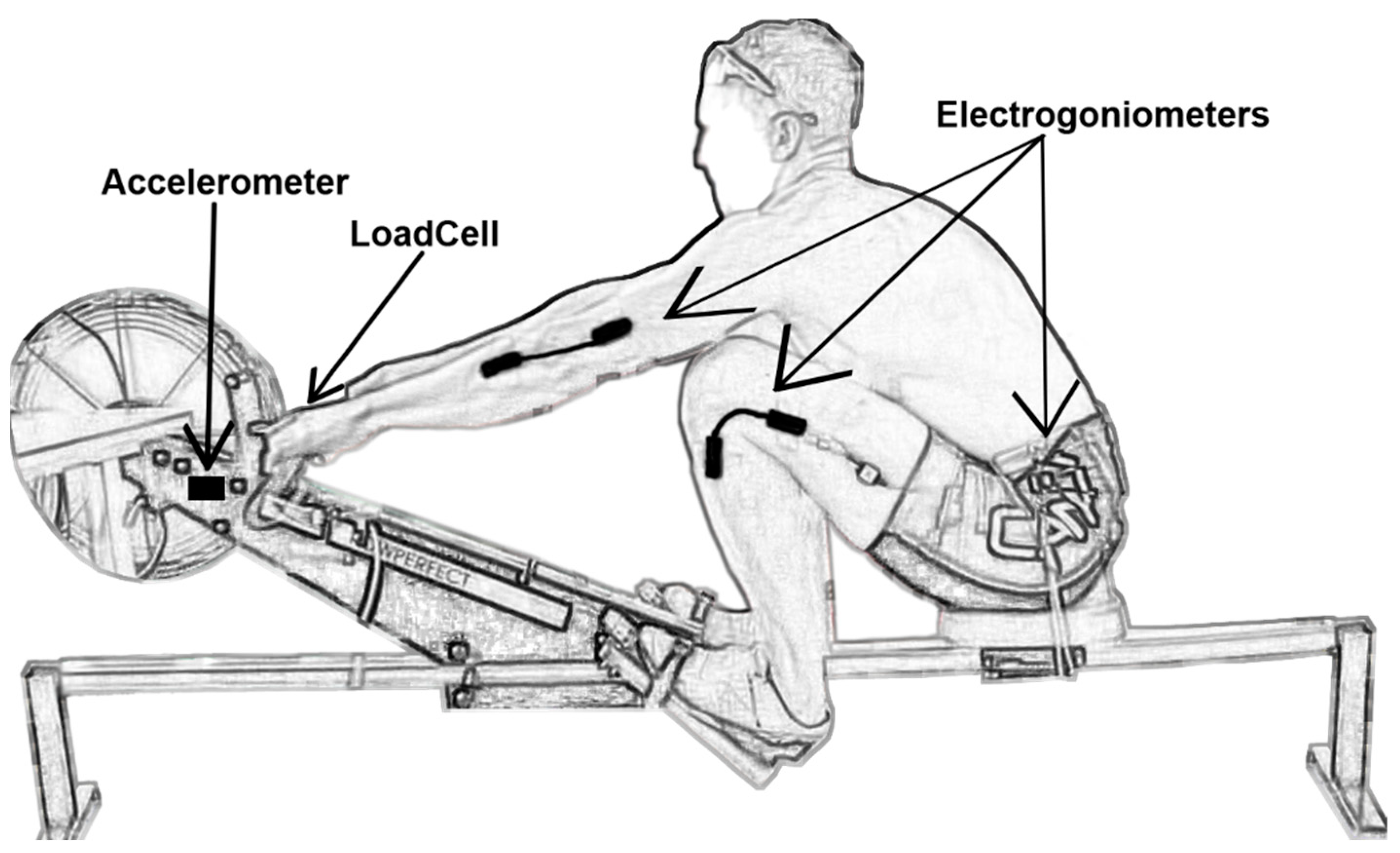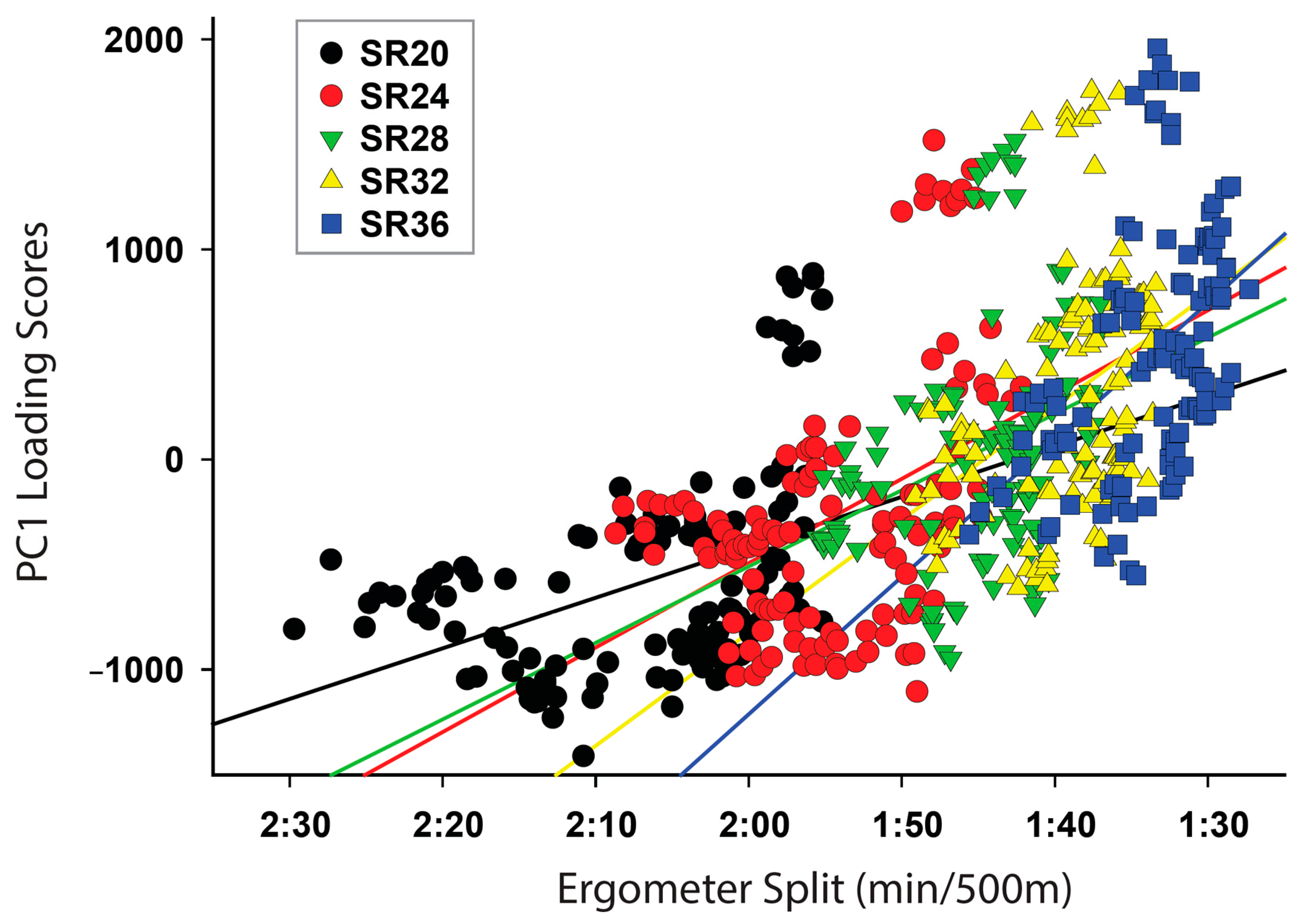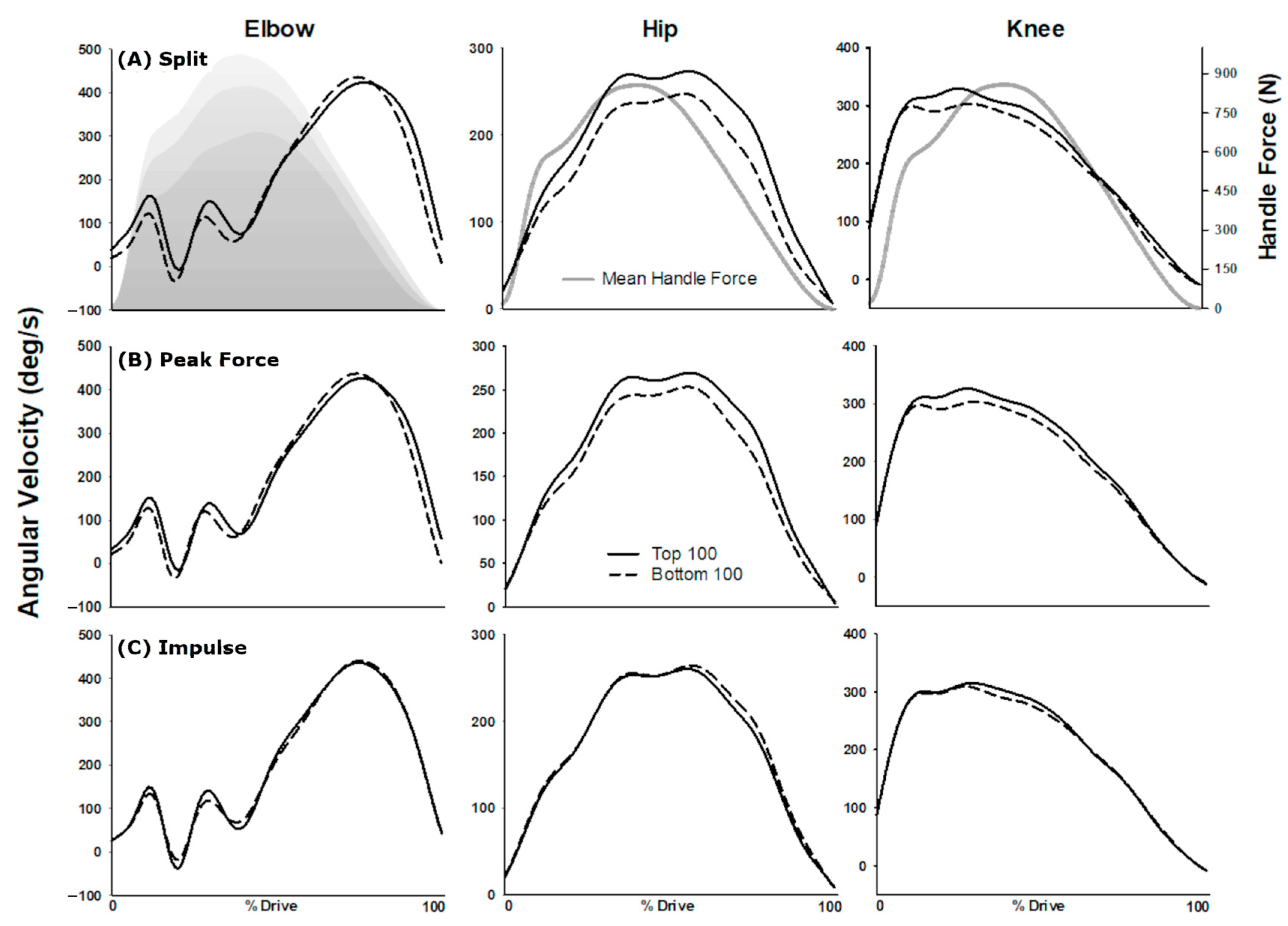Can Principal Component Analysis Be Used to Explore the Relationship of Rowing Kinematics and Force Production in Elite Rowers during a Step Test? A Pilot Study
Abstract
1. Introduction
2. Materials and Methods
2.1. Participants and Test Procedure
2.2. Data Collection
2.3. Data Analysis
2.4. Statistics
3. Results
3.1. Principal Components Analysis
3.2. Mean Kinematic Patterns
3.3. Stroke Kinematics Differentiated by Split Times
3.4. Stroke Kinematics Differentiated by Peak Force
3.5. Stroke Kinematics Differentiated by Impulse
3.6. Handle Force
3.7. Performance Variable and Individual Athlete Kinematic Association
4. Discussion
4.1. Identification of Kinematic Pattern Associated to Key Performance Metrics
4.2. Differences between Stroke Rate and Athletes
4.3. Support for Informed Performance Feedback
5. Conclusions
Author Contributions
Funding
Institutional Review Board Statement
Informed Consent Statement
Data Availability Statement
Acknowledgments
Conflicts of Interest
References
- Černe, T.; Kamnik, R.; Vesnicer, B.; Žganec, G.J.; Munih, M. Differences between elite, junior and non-rowers in kinematic and kinetic parameters during ergometer rowing. Hum. Mov. Sci. 2013, 32, 691–707. [Google Scholar] [CrossRef]
- Steer, R.; McGregor, A.H.; Bull, A. A comparison of kinematics and performance measures of two rowing ergometers. J. Sports Sci. Med. 2006, 5, 52–59. [Google Scholar] [PubMed]
- Vinther, A.; Alkjaer, T.; Kanstrup, I.L.; Zerahn, B.; Ekdahl, C.; Jensen, K.; Holsgaard-Larsen, A.; Aagaard, P. Slide-based ergometer rowing: Effects on force production and neuromuscular activity. Scand. J. Med. Sci. Sports 2012, 23, 635–644. [Google Scholar] [CrossRef]
- Buckeridge, E.M.; Hislop, S.; Bull, A.; McGregor, A.H. Kinematic asymmetries of the lower limbs during ergometer rowing. Med. Sci. Sports Exerc. 2012, 44, 2147–2153. [Google Scholar] [CrossRef]
- Bull, A.; McGregor, A.H. Measuring spinal motion in rowers: The use of an electromagnetic device. Clin. Biomech. 2000, 15, 772–776. [Google Scholar] [CrossRef] [PubMed]
- Giustino, V.; Zangla, D.; Messina, G.; Pajaujiene, S.; Feka, K.; Battaglia, G.; Bianco, A.; Palma, A.; Patti, A. Kinematics of Cervical Spine during Rowing Ergometer at Different Stroke Rates in Young Rowers: A Pilot Study. Int. J. Environ. Res. Public Heal. 2022, 19, 7690. [Google Scholar] [CrossRef]
- McGregor, A.H.; Patankar, Z.S.; Bull, A.M.J. Longitudinal changes in the spinal kinematics of oarswomen during step testing. J. Sports Sci. Med. 2007, 6, 29–35. [Google Scholar] [PubMed]
- McGregor, A.H.; Patankar, Z.S.; Bull, A.M.J. Spinal Kinematics in Elite Oarswomen during a Routine Physiological “Step Test”. Med. Sci. Sports Exerc. 2005, 37, 1014–1020. [Google Scholar]
- Pollock, C.L.; Jones, I.C.; Jenkyn, T.R.; Ivanova, T.D.; Garland, S.J. Changes in kinematics and trunk electromyography during a 2000 m race simulation in elite female rowers. Scand. J. Med. Sci. Sports 2010, 22, 478–487. [Google Scholar] [CrossRef]
- Hill, H. Dynamics of coordination within elite rowing crews: Evidence from force pattern analysis. J. Sports Sci. 2002, 20, 101–117. [Google Scholar] [CrossRef]
- Baudouin, A.; Hawkins, D. A biomechanical review of factors affecting rowing performance. Br. J. Sports Med. 2002, 36, 396–402. [Google Scholar] [CrossRef] [PubMed]
- Soper, C.; Hume, P. Towards an ideal rowing technique for performance: The contributions from biomechanics. Sports Med. 2004, 34, 825–848. [Google Scholar] [CrossRef] [PubMed]
- Anderson, R.; Harrison, A.; Lyons, G.M. Accelerometry-based feedback--can it improve movement consistency and performance in rowing? Sports Biomech. 2005, 4, 179–195. [Google Scholar] [CrossRef]
- Buckeridge, E.M.; Bull, A.M.J.; McGregor, A.H. Biomechanical determinants of elite rowing technique and performance. Scand. J. Med. Sci. Sports 2014, 25, e176–e183. [Google Scholar] [CrossRef] [PubMed]
- Turpin, N.A.; Guével, A.; Durand, S.; Hug, F. Effect of power output on muscle coordination during rowing. Eur. J. Appl. Physiol. 2011, 111, 3017–3029. [Google Scholar] [CrossRef]
- Witte, K.; Ganter, N.; Baumgart, C.; Peham, C. Applying a principal component analysis to movement coordination in sport. Math. Comput. Model. Dyn. Syst. 2010, 16, 477–488. [Google Scholar] [CrossRef]
- Robertson, D.G.E.; Caldwell, G.E.; Hamill, J.; Kamen, G.; Whittlesey, S.N. Research Mehods in Biomechanics, Second ed.; Human Kinetics: Champaign, IL, USA, 2013; Volume 428. [Google Scholar]
- Blake, O.M.; Champoux, Y.; Wakeling, J.M. Muscle coordination patterns for efficient cycling. Med. Sci. Sports Exerc. 2012, 44, 926–938. [Google Scholar] [CrossRef] [PubMed]
- Baudouin, A.; Hawkins, D. Investigation of biomechanical factors affecting rowing performance. J. Biomech. 2004, 37, 969–976. [Google Scholar] [CrossRef] [PubMed]
- Hofmijster, M.J.; Landman, E.H.; Smith, R.M.; Van Soest, A.J. Effect of stroke rate on the distribution of net mechanical power in rowing. J. Sports Sci. 2007, 25, 403–411. [Google Scholar] [CrossRef]
- Colloud, F.; Bahuaud, P.; Doriot, N.; Champely, S.; Chèze, L. Fixed versus free-floating stretcher mechanism in rowing ergometers: Mechanical aspects. J. Sports Sci. 2006, 24, 479–493. [Google Scholar] [CrossRef] [PubMed]
- McGregor, A.H.; Bull, A.; Byng-Maddick, R. A comparison of rowing technique at different stroke rates: A description of sequencing, force production and kinematics. Int. J. Sports Med. 2004, 25, 465–470. [Google Scholar] [CrossRef] [PubMed]
- Wakeling, J.M.; Horn, T. Neuromechanics of muscle synergies during cycling. J. Neurophysiol. 2009, 101, 843–854. [Google Scholar] [CrossRef] [PubMed]
- Doyle, M.; Lyttle, A.; Elliott, B. The Consistency of Force and Movement Variables as an Indicator of Rowing Performance. In Proceedings of the 28 International Conference on Biomechanics in Sports, Marquette, MI, USA, 19–23 July 2010. [Google Scholar]
- Jones, J.A.; Allanson-Bailey, L.; Jones, M.D.; Holt, C.A. An ergometer based study of the role of the upper limbs in the female rowing stroke. Procedia Eng. 2010, 2, 2555–2561. [Google Scholar] [CrossRef]
- Attenborough, A.S.; Smith, R.M.; Sinclair, P.J. Effect of gender and stroke rate on joint power characteristics of the upper extremity during simulated rowing. J. Sport. Sci. 2012, 30, 449–458. [Google Scholar] [CrossRef] [PubMed]
- Gorman, A.J.; Willmott, A.P.; Mullineaux, D.R. The effects of augmented biofeedback on novel motor-task learning. In Proceedings of the 33rd International Conference on Biomechanics in Sport, Poitiers, France, 29 June–3 July 2015; pp. 503–506. [Google Scholar]






| Split | Peak Force | Impulse | ||||
|---|---|---|---|---|---|---|
| Bottom | Top | Bottom | Top | Bottom | Top | |
| PC1 | −684 | 646 * | −610 | 450 * | ||
| PC2 | 190 | −72 * | ||||
| PC3 | 149 | −97 * | ||||
| PC4 | 98 | 193 | ||||
| PC5 | −357 | 76 * | ||||
| PC6 | 92 | 200 * | 33 | −79 * | −9 | 152 * |
| PC7 | −34 | 133 * | ||||
Disclaimer/Publisher’s Note: The statements, opinions and data contained in all publications are solely those of the individual author(s) and contributor(s) and not of MDPI and/or the editor(s). MDPI and/or the editor(s) disclaim responsibility for any injury to people or property resulting from any ideas, methods, instructions or products referred to in the content. |
© 2023 by the authors. Licensee MDPI, Basel, Switzerland. This article is an open access article distributed under the terms and conditions of the Creative Commons Attribution (CC BY) license (https://creativecommons.org/licenses/by/4.0/).
Share and Cite
Jensen, M.; Stellingwerff, T.; Pollock, C.; Wakeling, J.; Klimstra, M. Can Principal Component Analysis Be Used to Explore the Relationship of Rowing Kinematics and Force Production in Elite Rowers during a Step Test? A Pilot Study. Mach. Learn. Knowl. Extr. 2023, 5, 237-251. https://doi.org/10.3390/make5010015
Jensen M, Stellingwerff T, Pollock C, Wakeling J, Klimstra M. Can Principal Component Analysis Be Used to Explore the Relationship of Rowing Kinematics and Force Production in Elite Rowers during a Step Test? A Pilot Study. Machine Learning and Knowledge Extraction. 2023; 5(1):237-251. https://doi.org/10.3390/make5010015
Chicago/Turabian StyleJensen, Matt, Trent Stellingwerff, Courtney Pollock, James Wakeling, and Marc Klimstra. 2023. "Can Principal Component Analysis Be Used to Explore the Relationship of Rowing Kinematics and Force Production in Elite Rowers during a Step Test? A Pilot Study" Machine Learning and Knowledge Extraction 5, no. 1: 237-251. https://doi.org/10.3390/make5010015
APA StyleJensen, M., Stellingwerff, T., Pollock, C., Wakeling, J., & Klimstra, M. (2023). Can Principal Component Analysis Be Used to Explore the Relationship of Rowing Kinematics and Force Production in Elite Rowers during a Step Test? A Pilot Study. Machine Learning and Knowledge Extraction, 5(1), 237-251. https://doi.org/10.3390/make5010015





